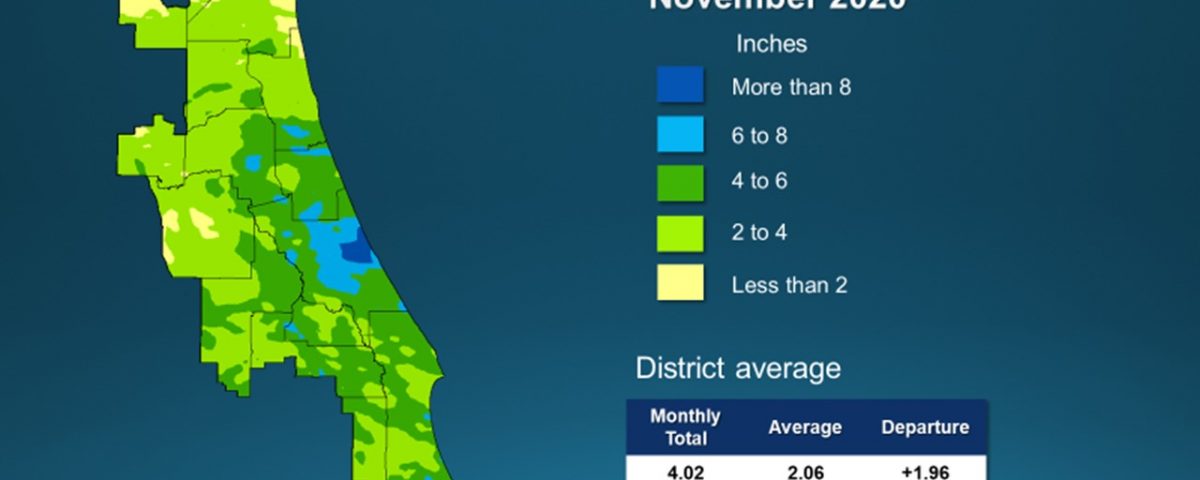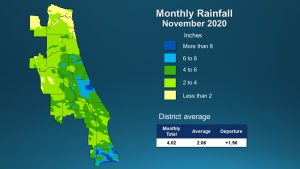November’s good news: No drought conditions, aquifer in high ranges, strong central Florida springflow

A map illustrates rainfall conditions in November across the St. Johns River Water Management District.

A map illustrates rainfall conditions in November across the St. Johns River Water Management District.
PALATKA, Fla., Dec. 8, 2020 — The final month of 2020’s Atlantic hurricane season ended with good news for most counties in the St. Johns River Water Management District: No drought conditions, the Floridan aquifer system is in the high ranges, and Orlando-area springs are experiencing strong flows.
A full report outlining hydrological conditions was presented at the St. Johns River Water Management District’s December Governing Board meeting Tuesday.
November’s hydrologic highlights include:
Rainfall
- Districtwide, November rainfall averaged 4.02 inches, nearly 2 inches above the long-term average for the month.
- Indian River (7.4 inches), Volusia (5.9 inches) and central coastal counties reported unusually high rainfall in November.
- Northern and western portions of the District’s 18-county region experienced drier conditions and were close to the long-term average of 2.06 inches.
- Baker County had the least rainfall, with 1.9 inches of rain.
- Districtwide, the cumulative rainfall total over the last 12 months is 53.12 inches, which is 2.11 inches above the long-term average.
- Volusia, northern Brevard and southern Indian River counties, have received well-above average rainfall for the past 12 months, while a few counties remain slightly below the long-term average. This includes St. Johns County, which has received 48.3 inches over the past 12 months.
Groundwater
- Upper Floridan aquifer conditions (groundwater levels) at the end of November were in the high range across much of the central and southern portions of the District, while most of the northern portion of the District recorded conditions in the normal range.
- Groundwater levels are at the 87th percentile Districtwide. This means that since 1980, aquifer levels have been higher than they are now about 13 percent of the time.
Surface water flows
- The St. Johns River’s headwaters were in very high flow range, while the Orlando area tributaries had high flows.
- Flow in the headwaters at the Melbourne station was 1.1 billion gallons per day (bgd) on Dec. 1, which is in the 90th percentile of flow conditions for this time of year.
- Further downstream, the St. Johns River DeLand station reported flows of 4 bgd (85th percentile) while the Satsuma station reported flows of 7.1 bgd (83rd percentile).
- Flow in the Econlockhatchee River near Chuluota was 142 million gallons per day (mgd) (86th percentile).
- Flows in the Wekiva River near Sanford were in the high range at 198 mgd (86th percentile).
- Flows in the Ocklawaha River, the largest tributary to the St. Johns River, were in the average range at 692 mgd (73rd percentile).
- The tidally influenced portion of the St. Johns River in Jacksonville was in the very high range due to a combination of flow, tide and meteorological factors.
- Flows in the St. Marys River near Macclenny were in the average range at 87 mgd (59th percentile).
Lake levels
- Lake Brooklyn water levels decreased slightly in November to 99.8 feet, remaining below its long-term average.
- Lake Weir, at 53.1 feet, did not change.
- Lake Apopka’s water level is consistent with its regulation schedule, with a slight increase in level mid-month. Lake Apopka is part of a system with water control structures that are operated by the District to reduce flood impacts, and the lake level is regulated according to a specific schedule.
- Blue Cypress Lake levels remained at 23.1 feet during November. Blue Cypress Lake is also part of a system with water control structures that are operated by the District.
Spring flows
- The mean monthly flow at Silver Springs decreased to 674 cubic feet per second (cfs), or 436.
- At the Blue Spring station in Volusia County, the mean monthly flow increased to 172 cfs, or 111 mgd, which is within the high flow range for the time of year.
- At Rock Springs, the monthly mean flow was 65 cfs (42 mgd), while mean monthly flow at Wekiwa Springs was 72 cfs (47 mgd).
To learn more about rainfall totals and other hydrologic data collected, visit sjrwmd.com.
Follow the water conservation conversation at #sjrwmd #waterconservation #savewater.

